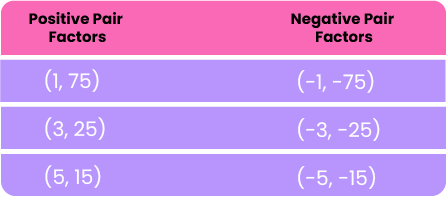Welcome to our exploration of the factors of 75. This blog will guide you through understanding the numbers that, when combined in various ways, give us a total of 75. Understanding these factors is crucial for those interested in mathematics, and we make it easy; whether you’re a math enthusiast or brushing up on your math skills, our guide is tailored for you. Let’s take an in-depth look at the number 75 and demystify its factors in an easy-to-grasp manner.
What Are the Factors of 75?
The factors of 75 are the numbers that, when combined through multiplication, yield the total of 75. These factor pairs are essential for understanding how different numbers interweave to form 75. Pairs like 1 and 75, 3 and 25, or 5 and 15, all multiply to 75.
Pair Factors of 75
The number 75 pair factors are sets of two numbers that result in 75 when multiplied together. This concept extends to both positive and negative pairs, as the multiplication of two negatives also yields a positive result.
Positive and Negative Pair Factors of 75:
How to Find the Factors of 75?
To find the factors of 75, you can follow these steps:
1. Start with the Number One:
Since 1 multiplied by any number gives that number itself, 1 and 75 form the first factor pair.
2. Check for Divisibility:
Incrementally test which numbers divide 75 evenly. For example, 3 times 25 and 5 times 15 are valid factor pairs.
3. Consider Square Roots:
Check numbers only up to the square root of 75. Factors beyond this will pair with smaller factors you have already found.
4. Don’t Forget Negatives:
Include the negative counterparts for each positive factor.
By following this method, you will identify the factors of 75: 1, 3, 5, 15, 25, and 75, along with their opposing counterparts: -1, -3, -5, -15, -25, and -75.
Prime Factorization Method
Prime factorization involves deconstructing a composite number to its prime components, the fundamental prime numbers that, when multiplied, reconstruct the original number.
The prime factorization of a number involves breaking it down into its most minor prime number factors. Here’s the process for 75:
1. Start with the Smallest Prime Number:
Begin with the smallest prime number that divides 75, which is 3.
2. Proceed with Division:
Divide 75 by 3, resulting in 25. Next, divide 25 by 5 (another prime number), which gives 5.
3. List the Prime Factors:
Since 75 is 3 times 5 times 5, and both 3 and 5 are prime numbers, the prime factorization of 75 is 3 × 5 × 5.
So, the prime factorization of 75 involves identifying the prime numbers that, when multiplied together, result in 75.
Summary
This guide provides a clear and concise understanding of the factors of 75. Learn how multiplication pairs such as 1 and 75, 3 and 25, 5 and 15, along with their negative equivalents, form the number 75. This guide not only lists these pairs but also simplifies the method of identifying them through division and the understanding of prime numbers. The prime factorization of 75, which breaks down to 3 multiplied by 5 and then by 5 again, clarifies the concept for those passionate about mathematics.
They not only deepen your mathematical understanding but also sharpen your problem-solving skills. Whether you’re in the classroom or facing real-world mathematical challenges, mastering these methods will undoubtedly prove beneficial.
Frequently Asked Questions on Factors of 75
Q1. What are the factors of 75?
Ans. The factors of 75 are numbers that multiply together to give 75: 1, 3, 5, 15, 25, and 75.
Q2. How do I calculate the factors of 75?
Ans. Start with 1 and progressively test which numbers up to 75 and divide it evenly.
Q3. Does 75 have negative factors?
Ans. Yes, each positive factor of 75 has a corresponding negative counterpart.
Q4. What is the prime factorization of 75?
Ans. The prime factorization of 75 is 3 multiplied by 5 and then by 5 again.
Q5. Are the factors of 75 useful in daily life?
Ans. Indeed, understanding the factors of 75 can be beneficial in various practical scenarios, like organizing objects or in mathematical problem-solving.
Moonpreneur understands the needs and demands this rapidly changing technological world is bringing with it for our kids. Our expert-designed Advanced Math course and Math Quiz for grades 3rd, 4th, 5th, and 6th will help your child develop math skills with hands-on lessons, excite them to learn, and help them build real-life applications.
Register for a free 60-minute Advanced Math Workshop today!















